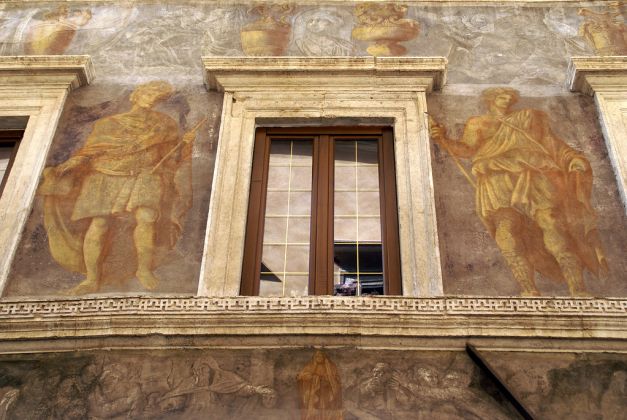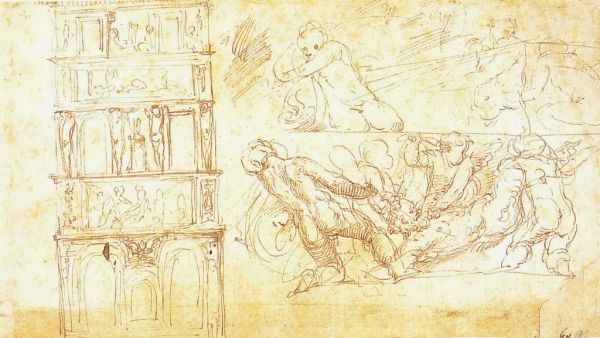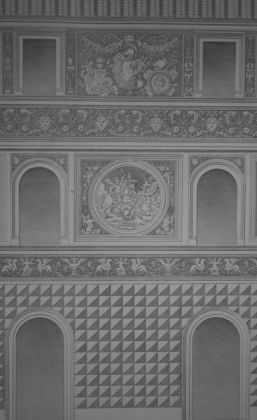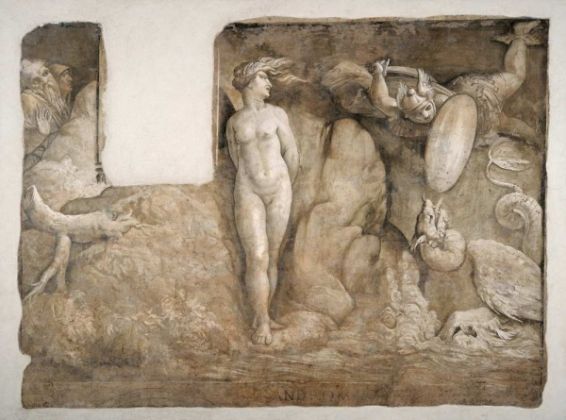Skilled artists embellished the façades of buildings in 15th- and 16th-century Rome but few survive today.
There exists – or rather, there used to exist – an “open-air art gallery” in Rome, most of which has nowadays been lost and the rest of which eludes the visitor’s eye. It is a mute, sometimes mysterious art, hidden among the alleys far from the traditional tourist routes.
But if you look up you can sometimes make out the fresco or graffito decorations which adorned the façades of Roman houses and buildings between the end of the 15th and the first half of the 16th century, following a fashion which in Italy started out in Venice, then became popular in Florence, and triumphed in Rome.
Here, among the numerous examples of classical, mediaeval and Renaissance beauty, skilled workers became expert in this decorative field, giving the city its “characteristic aspect, gay and triumphal,” as art historian Umberto Gnoli wrote in the review Il Vasari in 1937.
The foremost among these was Polidoro da Caravaggio, a pupil of Raffaello and the major exponent of this “fashion”, together with Maturino da Firenze, thanks to whom – as Vasari himself wrote in 1550 – “smiling Rome was enriched by their labours.”
Various sources, from the first guide-books on 17th-century Rome to the most modern studies, tell of more than 200 house-fronts decorated in techniques which developed over the years.
It progressed from graffito work simulating diamond-pointed rustication to ever more elaborate compositions in fresco, portraying for the most part, mythological scenes or scenes from Roman history, so that “this rebirth in full flower intrudes, festive and pagan, into papal Rome,” as one guide put it.
Even though it was a mainly northern practice, the origins of this explosion of decoration may be attributed not only to the presence of northern artists in Rome, but also to the rediscovery and revival of traditions such as the habit of hanging tapestries or carpets from the windowsills to mark processions or other festivities.
Why decorate the facades?
The reasons for adorning the outside of buildings with this rather than other techniques, however, can surely be attributed to more than a mere matter of taste: a perceptive choice, in that the façades appeared larger, and an aesthetic choice, given the power of the decorations to make even the most simple buildings look majestic. And there was also the motivation of prestige coupled with the reasonable cost of the execution of the work, giving a noble air to the house at a reduced expense.
What is left?
Sadly, of the 200 decorated façades recorded at the end of the 16th century, a mere 30 or so have survived.
Fortunately there are bibliographic sources, principally Vasari, and iconographic sources to preserve the memories: sketches, copies, prints and etchings like those by Alberti, Bonasone, Saenredam and Bartoli, or the 19th-century works by Enrico Maccari, Genesio Morandi and the Frenchman Paul Marie Letarouilly.
Restorations
But the chance to enjoy and admire this particular aspect of 16th-century Rome isn’t limited to visiting archives and libraries. Thanks to restoration work carried out in the mid-20th century, a few examples remain in situ. It’s possible to plan a walk to rediscover graffiti and frescoes which have been forgotten by art-history and guide books, relegating to oblivion works by artists of the calibre of Jacopo Ripanda, Baldassarre Peruzzi, Polidoro da Caravaggio, Perin del Vaga, Raffaellino da Reggio, Federico Zuccari, Maturino da Firenze or Daniele da Volterra.
Where to find them
Some splendid examples are hidden along the classical itineraries through the city centre, which also show the evolution of the techniques. Only a few steps from Piazza Navona, for example, in Via dell’Anima, we can look up at Tor Millina and its palazzo, whose decorations – dated at 1491 and attributed to Perin del Vaga – are sadly lost for the most part, but which survive in the drawings by Giovenale.
Continuing to no. 65, there are still traces of the inscriptions, friezes and crests on the house of the notary Sander. In Via della Fossa, behind Piazza del Fico, a decoration in diamond-pointed rustication still covers a large part of the façade of nos. 14-17, showing how this technique was used to simulate cladding in marble or other materials.
Close by lies Via della Maschera d’Oro with two of the best façades, an undeniable example of the development in technique and composition: a graffito decoration at no. 9, attributed to Baldassarre Peruzzi and portraying scenes from Roman history, and the well-known Palazzo Milesi, frescoed by Polidoro da Caravaggio in which we can still make out a frieze of the story of Niobe taken from Ovid’s Metamorphoses.
Crossing Corso Vittorio Emanuele at Chiesa Nuova in a narrow alley at no. 31 we find a splendid decoration, perhaps by Benvenuto Cellini after whom the street was named. Here, although we find the classical diamond-pointed rustication above it and the frieze with putti and girali (swirling leaf designs), there is a medallion with war scenes – barely legible, but reproduced by Maccari in the 19th century – which gives a grandeur to this little building which would otherwise be totally anonymous.
These are but a few examples of this alternative route through the streets of beauty in search of that grandiose but at times forgotten 16th-century Rome, and which still have something to reveal to the observant resident, student or tourist.
And without forgetting Guy Debord’s valuable advice: “You should be alienated and look at everything as though it were for the first time. One way to achieve this is to walk with measured steps and your gaze turned slightly upwards, so as to bring architecture to the centre of your field of vision and leave the street level at the lower edge of your sight. You should perceive space as a single unit and let yourself be attracted by the detail.”
by
Arianna Farina
PhD student at Ca'Foscari - IUAV, Venice.
ariannafar@yahoo.it





























